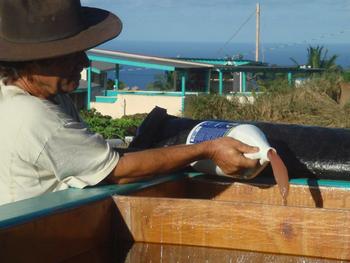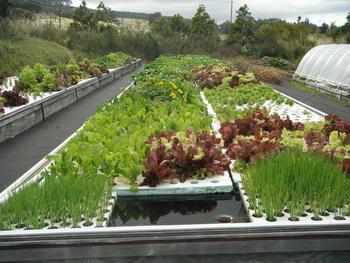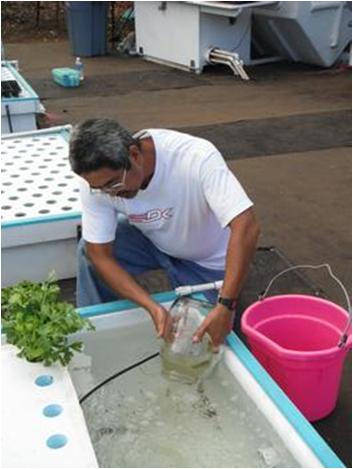System Startup And Inoculation Time
Is when you fill the system with clean water and introduce fish and nitrifying bacteria to begin the nitrification cycle which powers plant growth. Here are three simple ways to do it:
(Below) A third way to inoculate your system at startup.
|
Yet another effective way to inoculate your new system is simply by putting water from another aquaponics system into it. Larry Yonashiro of Aquaponics No Ka Oi on the island of Maui, inoculating this system with “living water” AND mosquito fish, from his own system of the same size. There are probably millions of the bacteria in this single gallon of his system’s water! There’s also an awesome aquaponic bok choy harvesting video Larry and Patty made at this YouTube address: https://www.youtube.com/watch?v=qz_GqBr1rac . |
How Inoculation And Nitrification Works:
We will tell you how to inoculate and startup your system (means getting the nitrification cycle started) in three simple paragraphs. If you follow instructions to the letter, everything will work fine. However, three paragraphs can’t possibly cover all the ways startup can get difficult, especially the ways that are out of your control. So first we’ll give you those three paragraphs, then we’ll fill a few pages with the things you might have to deal with, along with simple ways to avoid these difficulties.
- If you just fill your aquaponic system with water and put fish in it, it will start up all by itself. You can’t prevent it from starting up unless you do something really dumb. To start it sooner (so you have vegetables to eat sooner) simply “inoculate” it with some of the nitrifying bacteria that occur naturally in aquaponics water to begin nitrification. You can buy these from a mail-order company such as Aquatic EcoSystems (877-347-4788, on the web at AquaticEco.com), or at a local aquarium store. Don’t believe their salesman when they tell you “how much you need”. We were told we needed a gallon per 1,000 gallons of system water, yet we started up a 24,000 gallon aquaponics system quite nicely with a single $42 gallon of bacterial inoculant (24 of those would have been $1,800 with the shipping!).
- We recommend operating your system with 0.3 pounds of fish per square foot of raft area or media bed. However, we suggest starting your system with 10-20% or so of this recommended operating amount of fish. There are two reasons for this: first, it is difficult and/or expensive to just buy a large amount (by weight) of live fish. Second, until your nitrifying bacteria get well established and numerous, you do not want to inject too much ammonia into your system, which is what “too many fish” will do. Ammonia levels of 3 ppm or over in your water will slow down or stop nitrification (and your system startup) in its tracks, because the nitrifying bacteria in your inoculant are inhibited by too much ammonia, even though it’s their “food”.
- Although there are some nitrifying bacteria present in the water itself, these bacteria are primarily “surface colonizers”, which means that they live in colonies on solid surfaces; this is sometimes called a “biofilm”. There is a limited amount of surface area for them to colonize in your brand-new aquaponics system, and as a result, there is a limited amount of bacteria; and a limited amount of nitrification can occur because they can only process a small amount of ammonia. But, as you put baby plants into your system during startup, you are adding a tremendous amount of surface area (the bacteria colonize their roots too!), and as your plants grow and increase their root area, the bacteria colonize them and increase exponentially until there are zillions of them, and they can handle an incredible amount of ammonia.
- Let me explain that (darn! I went into four paragraphs!): I did a “back-of-the-napkin” calculation on the amount of plant roots in our system after doing a rough measurement and count of the roots on a few sample plants, and came up with a root surface area of around 60,000 square feet, in an aquaponics system of only 6,000 square feet! It was obvious that the amount of root area available for nitrification was many times the amount of system “area” represented by the sides and bottoms of the fish tank, the sides of the troughs, and the bottoms of the rafts!
When you have a new system that you’re just planting baby plants into, there’s very little root area for the bacteria to colonize. Later, when your system is mature and you have lots of big plants with tens of thousands of square feet of root area, there is much more root area for the bacteria to live on, and there is a lot of nitrification activity. This is why it’s easy to overload a young system with ammonia during startup; there simply aren’t enough bacteria yet to process it all into nitrites and then into nitrates, because there aren’t enough “condos” and “subdivisions” for the bacteria to live in yet. Once you’re through startup, you don’t need to worry about this again.
How To Inoculate
Any of the three methods in the previous photos works just fine! We start large new (15,000 gallons plus) systems with a non-refrigerated ProLine nitrifying bacteria concentrate in the one-gallon size for $42 (catalog #239211) from Aquatic EcoSystems (toll free at 877-347-4788), then put fish in immediately. If there’s a nearby clean aquaponics system (ie: no parasites, no fish diseases, no plant diseases, no duckweed, no crawfish in it), you can inoculate your system from it by bringing over water or plants and putting them in your system.
Don’t listen to the salesperson when they tell you that you need a gallon of this bacteria for each thousand gallons of water; this would have cost us $900 to start this 15,000 gallon system instead of the $70 we did spend (these numbers include shipping).
IMPORTANT! First, don’t add the inoculant until and unless your ammonia is lower than 3 ppm, preferably 1 ppm. Here’s why: nitrifying bacteria are inhibited by ammonia levels of 3 ppm or higher, and if you have higher ammonia, you won’t get system startup. Make sure you have less than 3 ppm ammonia in your system before wasting inoculating bacteria on it. If your ammonia is higher, dilute your water, pump for 12 hours to mix, measure again, THEN, when your ammonia is down to 1 to 2 ppm, add your innoculant bacteria.
WARNING: On one system we used the expensive Aquatic EcoSystems’ $317 gallon of bacteria (plus $180 UPS overnight shipping in a Styrofoam cooler), waited three weeks and nothing happened. Then we pumped over 400 gallons of water from another aquaponic system and had nitrites and nitrates within a couple of days. We have other reports of these bacteria and the $42/gallon bacteria not working and think AES just had a bad batch or two.
WARNING: Use the right test strips!!! We use LifeGard ammonia test strips and Hach # 27454 nitrite/nitrate test strips during startup to determine levels of ammonia, nitrites, and nitrates in the system. These strips are necessary because they show the low levels of nitrates that often occur during startup! Other strips and tests that are not as sensitive as these are often don’t show any nitrites or nitrates! We test once a day after adding the inoculant bacteria, until the startup process is complete. As the strips come 25 to a bottle, you probably need two bottles of each, as startup often takes 3 to 4 weeks to complete. If you don’t use these strips, or an equivalently sensitive type of test, it can look to you like there are no nitrites or nitrates. We can’t help you if you can’t accurately measure what your numbers are.
You don’t need to buy inoculant bacteria to start your second system, just pump over as much water as you can spare from your nearby existing system, and startup will be almost immediate; the water is full of nitrifying bacteria!



Leave a Reply